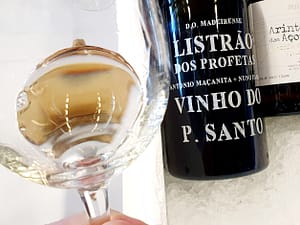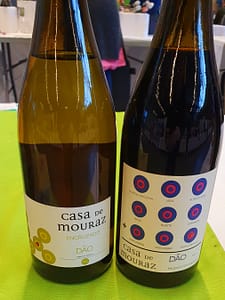A Portuguese island white was my first wine at yesterday’s tasting at Vinmonopolet, the Norwegian state monopoly. And what a start to the day! Producer Fitapreta is based in Alentejo, but winemaker António Maçanita is very active on the islands. Here is a wine made from palomino grapes grown in Porto Santo, brought to Madeira and finished there. Made with 30% whole bunches, 40 days of maceration, 8 months in used French barrels.
As the company explains on their website: On the island of Madeira, people from Porto Santo are called profetas (prophets), as a response to villões (villains), which the people of Porto Santo call Madeirans. The last nickname comes from vila (city), which thus takes on a double connotation. The wines of Profetas e Villões therefore reflect this duality.

Listrão dos Profetas 2021 (Profetas e Villões/ Fitapreta): Pale yellow color with some green. Intense nose with lemon peel, iodine and a flinty minerality. Rich and textured in the mouth, full of flavors with super acidity and a salty finish. Very persistent. This is Portuguese island white taken to a new level.

I have known António and Sara of Casa de Mouraz for many years now. Here I got the chance to re-taste two of their magnificent Dão wines. The Encruzado 2022 is one of the best examples of that variety that I know of. It’s fresh with notes of citrus, flowers and minerals, grapey in the mouth and full of flavours. Unfiltered, it comes really close to nature and the true quality of the grape. Casa de Mouraz Dão 2021 is a cherry red wine that smells like home at their estate, pine forest, red fruits and herbs. In the mouth it’s juicy with some spice.

Importer Non Dos also offered three magnificent sparklers. Two of them were from British producer Oxney, from East Sussex. Oxney 2019 is a complex wine with apples, peach, flowers, nuts and some brioche. Non vintage Oxney Rosé, with 25% seyval blanc, shows red berry fruit, apples and kind, with good concentration of flavours. They also represent Champagne house Fleury, here their Blanc de Noirs non vintage, that came with mature apples, dried fruits and biscuits, along with citrus and a stony minerality. Creamy in the mouth with good concentration.

Guro also poured many good wines that came with unbeatable prices. Various colours of Meinklang was among them. Their Rosa pouch (1,5 liters) in 2023 version was fabulous, with a clear-cut fruit of red berries and herbs, and with a distinct acidity leading to a delicately bitter finish. In spite of its everyday lightweight image it has a decent concentration.

the Wine Merchant is a subsidiary of Non Dos. Pierre here offered champagnes from Colin, that stands for an elegant, less autolysis-marked style. Their Parallèle is a long time favourite, clean, apple and citrus-driven with a layer of anise and herbs.

Selected Wine Partners presented a bunch of wines from Koncho of Kakheti, Georgia. Orange 2021 from rkatsiteli and kisi was light amber in colour, with evident skin-contact on the nose, with notes of orange peel and apricot, along with a full mouth-feel and a distinct acidity.
Leave a Comment















